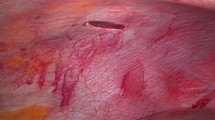Abstract
Since its conception and introduction in the early 1970s, diagnostic and therapeutic laparoscopy in trauma surgery has evolved rapidly. The literature on the advantages and feasibility of diagnostic and therapeutic laparoscopy in patients with abdominal trauma is extensive. Modern imaging techniques usually diagnose intra-abdominal lesions accurately but sometimes fail to detect an injury. It is particularly likely that diaphragmatic or small bowel injuries, which often require laparotomy, will be missed. But if an exploratory operation is performed routinely for every suspected abdominal injury, up to 41 % of those laparotomies will be nontherapeutic, i.e., pointless, and will place an unnecessary burden on patients and healthcare providers alike.
Diagnostic laparoscopy is performed to determine whether further surgery is needed, laparoscopic or conventional. Used in conjunction with computed tomography (CT) in the management of solid organ injuries, the presence or absence of occult lesions and the state of known injuries can be determined, allowing patients to be selected correctly for operative or nonoperative management.
With penetrating trauma laparoscopy is superior to conventional methods for assessing peritoneal damage, particularly lower chest stab wounds and entry and exit gunshot wounds in patients without diffuse peritoneal signs who are hemodynamically stable.
Laparoscopy is a valuable tool not only for diagnosis but also for treatment: Small diaphragmatic wounds can be sutured, stapled, or covered with prosthetic mesh; gastrointestinal perforations can be closed; and hemostasis be achieved in low-grade liver and splenic lacerations with simple sutures, collagen fleece tamponade, or biological sealants, applied through the laparoscope.
Laparoscopy in the trauma setting has its benefits and risks, which must be weighed in establishing indications. Laparoscopy reduces the rate of nontherapeutic negative laparotomies and allows shorter hospitalization. The main risk with trauma patients is that in case of conversion definitive treatment may be delayed; other risks are missed injuries and naturally procedure-related complications that can occur with any laparoscopy. It cannot be overstressed that hemodynamic stability is an absolute prerequisite for laparoscopy.
In summary, laparoscopy can be a safe and effective option in the management of stable patients with abdominal trauma. The most important advantages are reduction of morbidity and avoidance of prolonged hospitalization for observation, both of which reduce costs.
Technological advances have continuously improved laparoscopy equipment, and this trend can be expected to carry on and embrace computer technology and robotic devices, all of which will have a positive influence on treatment of trauma patients.
Access this chapter
Tax calculation will be finalised at checkout
Purchases are for personal use only
Similar content being viewed by others
References
Ballard RB, Rozycki GS, Newman PG et al (1999) An algorithm to reduce the incidence of false-negative FAST examinations in patients at high risk for occult injury. J Am Coll Surg 189:145–151
Carnevale N, Baron N, Delany HM (1977) Peritoneoscopy as an aid in the diagnosis of abdominal trauma: a preliminary report. J Trauma 17:634–641
Choi YB, Lim KS (2003) Therapeutic laparoscopy for abdominal trauma. Surg Endosc 17(3):421–427
Gazzaniga AB, Stanton WW, Bartlett RH (1976) Laparoscopy in the diagnosis of blunt and penetrating injuries to the abdomen. Am J Surg 131:315–318
Heselson J (1970) Peritoneoscopy in abdominal trauma. S Afr J Surg 8:53–61
Ivatury RR, Simon RJ, Siahl WM (1993) A critical evaluation of laparoscopy in penetrating abdominal trauma. J Trauma 34:822–828
Killeen KL, Shanmunagathan K, Poletti PA et al (2001) Helical computed tomography of bowel and mesenteric injuries. J Trauma 51:26–36
Livingstone DH, Tortella BJ, Blackwood J et al (1992) The role of laparoscopy in abdominal trauma. J Trauma 33(3):471–475
Mihos P, Potaris K, Gakidis J et al (2003) Traumatic rupture of the diaphragm: experience with 65 patients. Injury 34:169–172
Rozycki GS, Ballard RB, Feliciano DV et al (1998) Surgeon-performed ultrasound for the assessment of truncal injuries: lessons learned from 1540 patients. Ann Surg 228:557–567
Shanmunagathan K, Mirvis SE, Chiu WC et al (2004) Penetrating torso trauma: triple contrast helical CT in peritoneal violation and organ injury – a prospective study in 200 patients. Radiology 231:775–784
Smith RS, Fry WR, Morabito DJ et al (1995) Therapeutic laparoscopy in trauma. Am J Surg 170:632–636
Uranüs S, Pfeifer J (2001) Nonoperative treatment of blunt splenic injury. World J Surg 5:1405–1407
Uranues S, Fingerhut A, Bergamaschi R (2011) Laparoscopic procedures in trauma care. In: Oestern HJ, Trentz O, Uranues S (eds) Trauma surgery I – Head, thoracic, abdominal, and vascular injuries. Springer, Berlin/Heidelberg, pp 343–349
Villavicencio RT, Aucar JA (1999) Analysis of laparoscopy in trauma. J Am Coll Surg 189:11–20
Author information
Authors and Affiliations
Corresponding author
Editor information
Editors and Affiliations
2.1 Electronic Supplementary Material
Below is the link to the electronic supplementary material.
Laparoscopic_Diaphragmatic_Repair_Di_Saverio_1_LOW_RES (WMV 187 MB)
Laparoscopic_Diaphragmatic_Repair_Di_Saverio_2_LOW_RES_Exploration (WMV 26.9 MB)
Rights and permissions
Copyright information
© 2014 Springer-Verlag Italia
About this chapter
Cite this chapter
Uranues, S., Fingerhut, A. (2014). Laparoscopy for Trauma: When, What, How?. In: Di Saverio, S., Tugnoli, G., Catena, F., Ansaloni, L., Naidoo, N. (eds) Trauma Surgery. Springer, Milano. https://doi.org/10.1007/978-88-470-5459-2_2
Download citation
DOI: https://doi.org/10.1007/978-88-470-5459-2_2
Published:
Publisher Name: Springer, Milano
Print ISBN: 978-88-470-5458-5
Online ISBN: 978-88-470-5459-2
eBook Packages: MedicineMedicine (R0)




